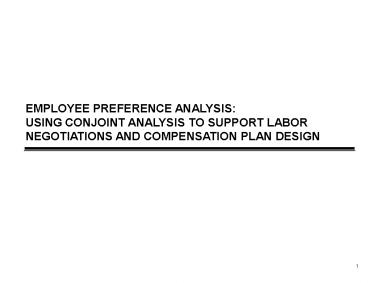The Merger Integration Challenge PowerPoint PPT Presentation
1 / 9
Title: The Merger Integration Challenge
1
EMPLOYEE PREFERENCE ANALYSIS USING CONJOINT
ANALYSIS TO SUPPORT LABOR NEGOTIATIONS AND
COMPENSATION PLAN DESIGN
2
I - INTRODUCTION
3
Every year school districts make decisions that
have significant implications for the district
and its employees without the benefit of basic
information on employee preferences and priorities
Introduction
- In two areas in particular - labor negotiations
and the design of employee compensation and
benefits plans - decisions are often made without
adequate information - While districts make a significant effort to
understand employee priorities before entering
labor negotiations or designing benefits
packages, the results of these efforts tend to be
qualitative and anecdotal - In the absence of quantitative information
information on employee needs and priorities,
district managers have little choice but to defer
to labor leaders to accurately represent the
views of employees - While most labor leaders work diligently to
fairly reflect the views of the workers they
represent, in many cases they too would benefit
from a more detailed analysis of employee
preferences and priorities - Given the costs and operational consequences
associated with labor contracts and benefits
packages negotiating agreements without a firm
understanding of employee preferences and
priorities should be avoided if possible
4
Conjoint analysis provides a powerful tool for
addressing the need to better understand employee
priorities
Introduction
- Conjoint analysis is a statistical tool that
market researchers have used for more than 30
years to help private sector companies understand
how to develop products and services that are
valued by customers - The results of conjoint analysis are used to
answer two basic questions - What product or service attributes do my
customers care about? - What are the most preferred service attributes?
- Conjoint analysis can also be used to support
labor negotiations and to design compensation and
benefits packages that reflect employee
preferences and priorities - For example, conjoint analysis can be used to
gather quantitative information on how rank and
file employees value various issues being
considered as part of a labor negotiation - Likewise, conjoint analysis results can be used
to structure compensation and benefit packages
that best reflect how workers value the
individual components of their total compensation
5
II - USING THE CONJOINT ANALYSIS PROCESS
6
The conjoint analysis process consists of a
number of steps
Using The Conjoint Analysis Process
- The first step consists of defining the key
attributes or features of the the activity being
evaluated - For example, for employee compensation and
benefits each type of benefit being evaluated
would be identified (e.g., wages and salary, life
insurance, disability insurance, health
insurance, etc.) - After defining the key features or attributes of
an activity, values or options for each feature
or attribute will be selected - In the employee compensation and benefits example
different salary levels would be listed as would
options for various types of benefits - For example, different prescription co-payment
options, out-of-pocket expenses and provider
options might be included for employee health
benefits - A survey instrument will then be prepared and
administered that asks employees to express their
preferences for various alternatives
7
Conjoint analysis will then be used to quantify
employee preferences
Using The Conjoint Analysis Process
- Conjoint analysis will then be used to evaluate
survey results - The value employees place on an attribute will be
calculated. - This value can be used to compare the importance
of the attributes - Information on the relative value of various
alternative can then be compared to their costs - In particular, options that are costly but are
not valued by employees can be discarded - In addition, options for which differences in
cost seem disproportionate to differences in
value would be subject to scrutiny - For example, if the difference in cost between
one option and another is 50 percent but the
difference in value is only 15 percent providing
the higher priced option may not be sound - On the other hand, if the difference in cost is
15 percent but the difference in value is 50
percent pursuing the option may be worthwhile
8
III - HOW BERKSHIRE ADVISORS CAN SUPPORT EFFORTS
TO USE USE CONJOINT ANALYSIS TO SUPPORT LABOR
NEGOTIATIONS AND THE DESIGN OF COMPENSATION AND
BENEFITS PLANS
9
Berkshire Advisors supports efforts to use
conjoint analysis to support labor negotiations
in a number of ways
How Berkshire Advisors Can Support Efforts To Use
Conjoint Analysis To Support Labor Negotiations
- Assist in identifying key options to be assessed
using conjoint analysis - Develop survey instrument
- Administer the survey
- Analyze and document survey results
- Assist in using conjoint analysis results to
assess options - Conduct follow-up conjoint analysis surveys as
needed

